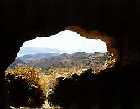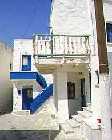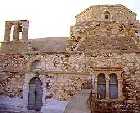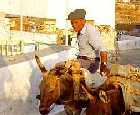Kimolos Characteristics
Kimolos lies one km from the island of Milos. It's the smaller of the two. Although quiet, it does receive a steady trickle of visitors.




Milos and Kimolos were connected by a
now sunken land bridge. The smaller island has a land mass of 37 sq. km. and
a coast line of 38 km. Kimolos is 86 nautical miles from Piraeus
and has a population of 800.
The hilltop capitol of Kimolos is Kimolos Town or Hora, a (2km) fifteen minute walk from
the port Psathi. Kimolos
has nice deserted beaches and radioactive thermal springs good for
rheumatism. At the center of the island the fortress of Paleokastro perches on a high cliff.
Island Features
Kimolos' quiet, untouched style is not great for party seekers, but it's haven to some interesting animals and plants. The sixth rarest
animal in Europe, the Mediterranean Monk Seal has been spotted around Kimolos as has the 100 million year old
Loggerhead turtle which lay
their nest eggs in the sands of the beach of Elliniko.
These species are both protected by Greek and International law.
There are only about 600 seals left
and most of them live in the Sporades Marine Reserve around
Allonisos Island. The island is home to a species of rare blue lizard.
Mostly rocky and barren, Kimolos can surprise you with green patches, including 140 species of rare plants on the southeast coast.
The
modern name of the island means chalk in Greek. Kimolos is
one of the world's top producers of the substance Cimolite, deemed
essential to the dying of cloth. It's similar to the soft chalk-like Fuller's Earth. Kimolos also
possesses the last truly working windmill in the Cyclades.
Towns



Kimolos
Town or Hora was designed to confuse pirates and is a small labyrinth of white
buildings strewn with strategically placed flower pots which contrast
nicely with the stark whitewash of the buildings. On the way up to town you'll pass the Afendakis Foundation World
Headquarters with the island's museum in the basement. You'll see Mr.
Afendakis statue outside. Within is an amalgamation of various ancient
knickknacks and ostraka (pot-shards) the Kimolotes have dug up
over the years.
Hora is divided into
two parts: Inner Hora-Kastro or old town and Outer Hora-Kastro or new
town. The houses of the inner Kastro form the inside of the fortress with loophole windows and four gates. New Town has a smattering of cafes and tavernas and its beautiful
domed Greek Orthodox Cathedral Panagia Evangelistria, built in 1614. Other
Churches include Taxiarchis (1670), Panagia Odygitira (1873) and Chrisotomas (1680). There are six windmills, one of which actually produces stone ground wheat even today.
The village sprang
up around its Venetian Castle built by Marco Sanudo and occupying
Kimolos' high point at 355m. Kimolos oldest Church of Christos (1592)
sits within the Kastro. The views are good!
Beaches and Sights

 Walk south east down
the village road towards Milos just opposite and you'll eventually be
where the isthmus connecting the two islands used to be. On the way you'll
pass through Aliki with a beach and a taverna and further along will
come to Aghios Andrea and the ruins of the ancient city that once occupied
the isthmus and has now sunk into the sea. All that remains is the ancient
cemetery or Elliniko Necropolis which has graves from the Mycenaean
period on into the the early part of the 1st millennium.
Walk south east down
the village road towards Milos just opposite and you'll eventually be
where the isthmus connecting the two islands used to be. On the way you'll
pass through Aliki with a beach and a taverna and further along will
come to Aghios Andrea and the ruins of the ancient city that once occupied
the isthmus and has now sunk into the sea. All that remains is the ancient
cemetery or Elliniko Necropolis which has graves from the Mycenaean
period on into the the early part of the 1st millennium.
Two beaches
are close by: Elliniko and Kambana. Kambana is a favorite of
the turtles for nesting so don't stick your umbrella too deep into the
sand.

 A path
north from Hora will lead you to the fishing hamlet of Goupa with
perhaps the best fishing in the Aegean. It has a totally unspoiled
beach.
A path
north from Hora will lead you to the fishing hamlet of Goupa with
perhaps the best fishing in the Aegean. It has a totally unspoiled
beach.
Beyond is the beach of Klima. At the north tip of Kimolos
is Prassa and the radioactive springs. Prassa is where the
cimolite is dug up and processed. Under certain conditions the
chalk dust formed covers the whole island with a light coating. Opposite
the east coast of Kimolos is the islet of Poliegos where
monk seals have been spotted. Poliegos is inhabited only by goats.
There is freelance camping allowed.
Drinking and Dining
There are very
few amenities on Kimolos. At last count there were five tavernas, two bakeries and a mini-mart.
Kimolos was known in ancient times
as Echinousa for its many sea urchins which were also depicted
on its ancient coins. "A-hee-nee" are not to be
tread upon, if possible. To their credit, sea urchins are rumored
to posses Viagra-like properties. They may be eaten raw after being
dislodged with a diving knife from the rocks to which they cling.
They don't yield much meat however, being pretty much hollow. Nor
do they taste like much of anything either. Aficionados liberally
annoint them with lemon juice and claim they are an acquired taste.




